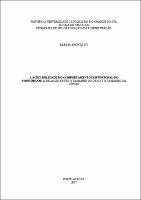| Share record |


|
Please use this identifier to cite or link to this item:
https://tede2.pucrs.br/tede2/handle/tede/7351| Document type: | Dissertação |
| Title: | A aceitabilidade do comportamento disfuncional do consumidor : a relação entre o tamanho do dano e o tamanho da vítima |
| Author: | Bronzatti, Rafael  |
| Advisor: | Espartel, Lélis Balestrin |
| Abstract (native): | O comportamento disfuncional do consumidor (CDC) tem sido tema recorrente em estudos no campo do marketing e da ética nas últimas décadas. Análises do fenômeno envolvem desde os principais tipos, motivadores, inibidores e outras variáveis que influenciam na ocorrência do mesmo. Duas variáveis importantes no estudo dos comportamentos disfuncionais são a sua severidade e a vítima do CDC. A severidade, ou gravidade, pode ser representada pelo tipo de comportamento e também pelo tamanho dos danos; a vítima pode ser representada pela empresa, marca, funcionários ou mesmo outros clientes. Poucos estudos analisaram conjuntamente o tamanho dos danos e o tamanho da vítima; contudo, sabe-se que grandes empresas são vítimas mais frequentes de CDC. Nesta pesquisa, a severidade foi representada pelo tamanho dos danos causados em dois tipos diferentes de CDC, enquanto que a vítima foi traduzida na empresa que sofre com os prejuízos causados pelo consumidor. Foram realizados dois estudos que analisaram os efeitos do tamanho dos danos e do tamanho da vítima na aceitabilidade do comportamento disfuncional. O estudo 1 analisou estes efeitos tendo como base um cenário com comportamento passivo, onde o consumidor tira proveito de uma falha da empresa, enquanto que o estudo 2 utilizou um comportamento ativo, com clara intenção do consumidor cometer o CDC, mas os prejuízos ao varejista não são claros. Os resultados indicaram que a aceitabilidade do comportamento disfuncional varia de acordo com o tipo de CDC e o tamanho dos danos e que quando é praticado contra grandes empresas é considerado mais aceitável do que quando praticado contra pequenas empresas. Estes resultados corroboram os achados de outros estudos e o proposto pela teoria da distância social e o Robin Hood Effect. |
| Abstract (english): | The dysfunctional customer behavior (DCB) has been a frequent theme among studies in the marketing and ethics field in the last decades. The phenomenon analysis involves since the main types, motivators, inhibitors and other variables that influence its occurrence. Two important variables in the study of the dysfunctional behaviors are its severity and the victim of de DCB. Severity, or gravity, can be represented by the type of behavior and also by the size of the injury; the victim can be represented by a firm, brand, employees or even by other clients. Few studies have analyzed, jointly, the size of the injury and the size of the victim; however, it is known that big firms are the most frequent victims of the DCB. In this research, severity was represented by the size of the injuries caused by two different types of DCB, and the victim refers to the firm that suffers the prejudice caused by the customer. Two studies were performed in order to analyze the effects of the size of the injuries and the size of the victim on the acceptability of the dysfunctional behavior. Study 1 analyzed these effects based on a passive behavior scenario, where the customer takes advantage of a firm’s mistake, while study 2 were based on an active behavior, with the clear intention of the customer to commit DCB, but the prejudice to the retailer are not clear. Results have indicated that the dysfunctional behavior acceptability varies according to the type of DCB and the size of of the injuries and that when it is practiced against big firms it is considered more acceptable than when practiced against small firms. These outcomes corroborate other studies findings and what is proposed by the social distance theory and the Robin Hood Effect. |
| Keywords: | Comportamento Disfuncional do Consumidor Severidade Aceitabilidade Ética Distância Social Robin Hood Effect |
| CNPQ Knowledge Areas: | CIENCIAS SOCIAIS APLICADAS::ADMINISTRACAO |
| Language: | por |
| Country: | Brasil |
| Publisher: | Pontifícia Universidade Católica do Rio Grande do Sul |
| Institution Acronym: | PUCRS |
| Department: | Escola de Negócios |
| Program: | Programa de Pós-Graduação em Administração e Negócios |
| Access type: | Acesso Aberto |
| URI: | http://tede2.pucrs.br/tede2/handle/tede/7351 |
| Issue Date: | 29-Mar-2017 |
| Appears in Collections: | Programa de Pós-Graduação em Administração e Negócios |
Files in This Item:
| File | Description | Size | Format | |
|---|---|---|---|---|
| DIS_RAFAEL_BRONZATTI_COMPLETO.pdf | Texto Completo | 1.56 MB | Adobe PDF |  Download/Open Preview |
Items in DSpace are protected by copyright, with all rights reserved, unless otherwise indicated.




